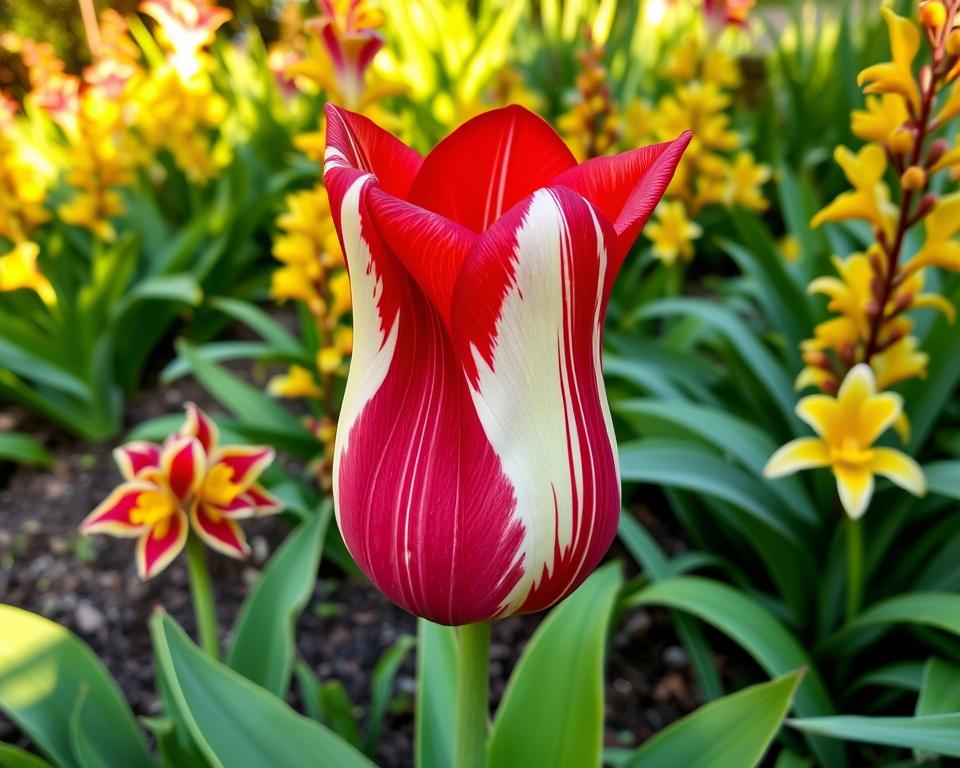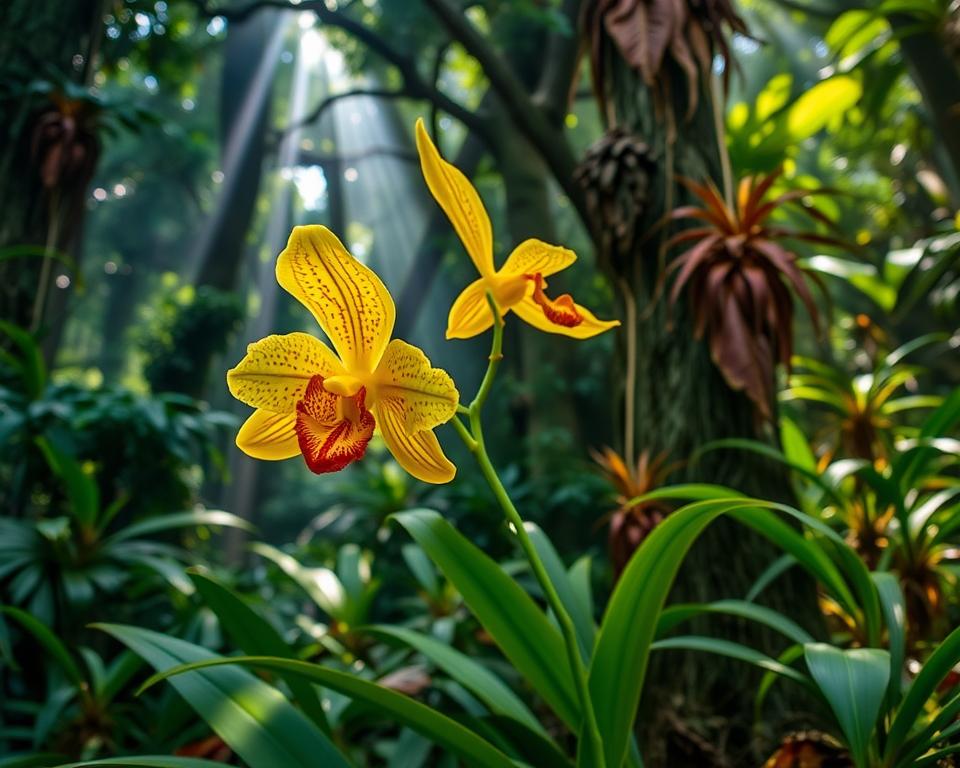How to Grow Freesia Flowers: A Step-by-Step Guide
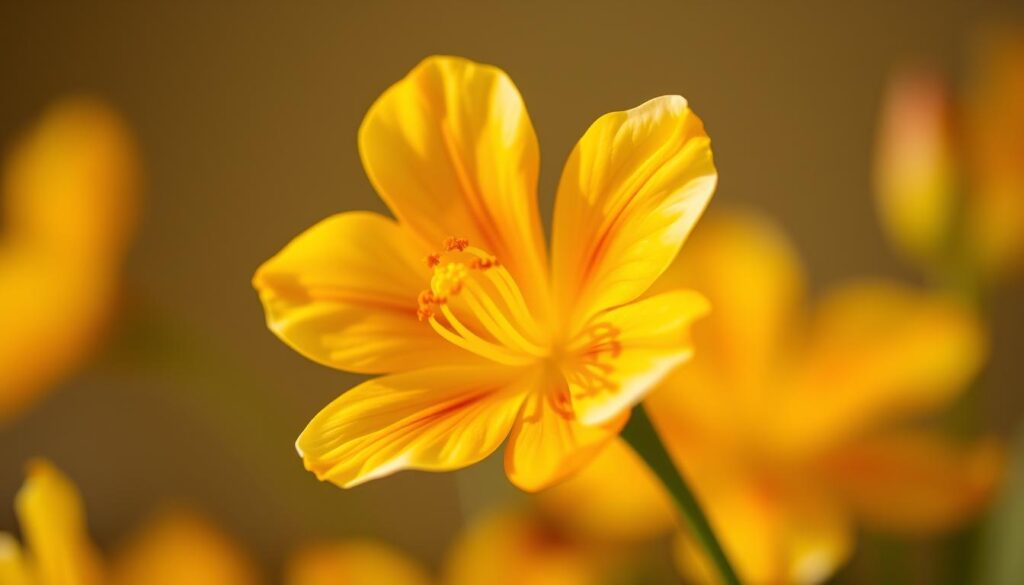
Freesia flowers are known for their sweet scent and stunning blooms. They are a favorite among gardeners.
Growing freesias can be very rewarding. With the right steps, anyone can enjoy freesia’s beauty and fragrance in their garden.
Following a step-by-step guide helps gardeners learn about freesia care. This includes choosing the right varieties and caring for the plants.
Whether you’re experienced or new to gardening, growing freesias can be a fun and rewarding experience. With the right knowledge, you can enjoy freesia flowers in your garden.
Introduction to Freesia
Freesia flowers are loved by gardeners for their easy care and stunning looks. They have delicate, funnel-shaped blooms and a sweet scent. With the right care, they can bloom beautifully and fill your garden with color and fragrance.
Freesia flowers are versatile and come in many colors like white, yellow, orange, and pink. They are also easy to care for, needing little to stay healthy and vibrant.
To care for freesia flowers, give them well-draining soil and full sun to partial shade. They need regular water but avoid overwatering to prevent root rot. With proper care, they can bloom for weeks, adding beauty and fragrance to your garden.
Overview of Freesia Flowers
Freesia flowers are a type of bulbous perennial that come back every year with the right care. They grow to be about 12-18 inches tall, perfect for adding color without taking up much space. Their delicate blooms and sweet scent make them a great choice for garden beauty and elegance.
| Characteristics | Benefits |
|---|---|
| Delicate, funnel-shaped blooms | Add a touch of elegance to your garden |
| Sweet fragrance | Provide a beautiful scent to your garden |
| Low maintenance | Require minimal freesia care |
Choosing the Right Freesia Varieties
Gardeners have many freesia varieties to pick from. Each type has its own look and smell. Some are known for their strong scent, while others have bright colors.
For more information, check out the freesia varieties page. It has details on each type, like their looks and where they come from. This helps gardeners pick the best freesia bulbs for their garden.
Popular freesia types include F. ‘Red Lion’ and F. ‘Golden Yellow’. They have bright colors and a sweet smell. These varieties add color and fragrance to your garden.
Popular Freesia Cultivars
There are many freesia cultivars to choose from. Each has its own special traits. By picking the right bulbs and caring for them, you can enjoy their beauty and scent for months.
Colorful Choices for Your Garden
Gardeners can pick from many colorful freesia varieties. This lets them create a lively and stunning garden. Whether you like bold colors or soft ones, there’s a freesia for you.
Preparing the Soil for Freesia
Preparing the soil is key for growing freesias. The right soil quality and texture are crucial. They provide the nutrients your freesia plant needs to thrive.
Test the soil before planting to check its pH level and nutrient content. This helps you know what amendments to add. With the right care, your garden will bloom with vibrant freesia flowers.
Soil Quality and Texture
The best soil for freesias is well-draining and rich in organic matter. Mixing compost and perlite can improve soil structure. This prevents waterlogged soil and supports healthy root growth.
Ideal pH Levels for Freesia
Freesias do well in slightly acidic to neutral soil, with a pH of 6.0 to 7.0. If your soil is off, add lime or sulfur to adjust it. By following these tips, you can create a perfect environment for your freesia plant.
| Soil pH | Ideal Range |
|---|---|
| Acidic | Below 6.0 |
| Neutral | 6.0-7.0 |
| Alkaline | Above 7.0 |
Planting Freesia Bulbs
Timing is key when planting freesia bulbs. The best time is in the fall or early spring when it’s cooler. This lets the bulbs grow strong before summer heat or winter cold.
Choose a spot with well-draining soil and full sun to partial shade. Freesia plants like slightly acidic soil, with a pH of 6.0 to 7.0.
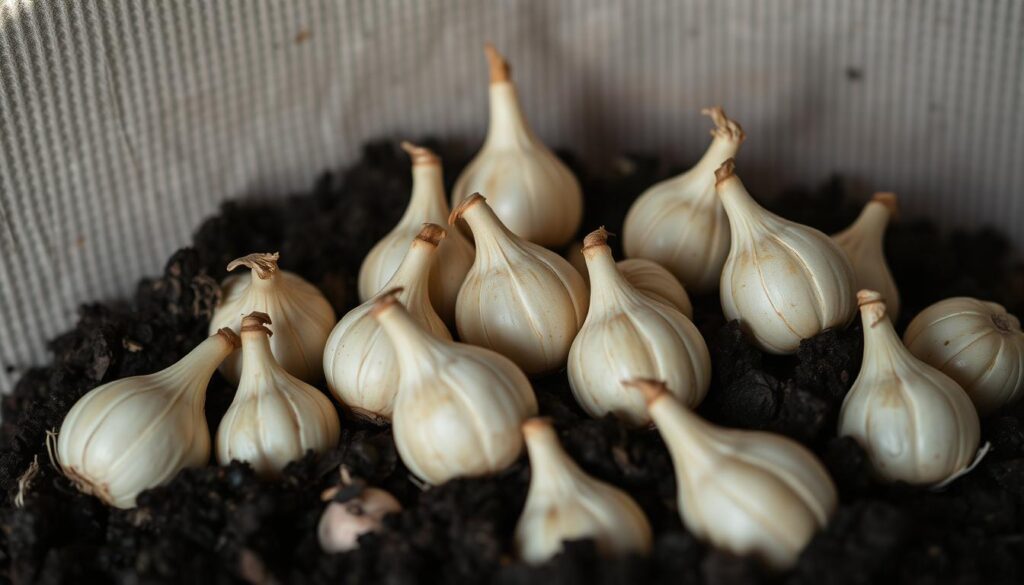
Before planting, enrich the soil with compost or well-rotted manure. This boosts soil quality and fertility. Plant the bulbs 2-3 inches deep and 3-4 inches apart, based on the variety. Water well after planting and keep the soil moist during the first growing season.
Best Time to Plant
Plant freesia bulbs in the fall, 6-8 weeks before the first frost. This helps them grow strong before winter. In mild winters, plant in early spring when the soil is workable.
How to Plant Bulbs Properly
Dig a hole 2-3 times deeper than the bulb. Add compost or manure at the bottom. Place the bulb in the hole, cover with soil, and water well. Make sure the bulb’s nose faces upwards.
Spacing Requirements
Spacing depends on the bulb variety. Plant small varieties 3-4 inches apart and larger ones 6-8 inches apart. This ensures they have enough room to grow and bloom.
| Variety | Spacing | Depth |
|---|---|---|
| Small | 3-4 inches | 2-3 inches |
| Medium | 4-6 inches | 3-4 inches |
| Large | 6-8 inches | 4-5 inches |
Care and Maintenance of Freesia
To keep your freesia plant healthy, follow some key care steps. This includes knowing how to water and fertilize it. Watering is crucial; too much can cause root rot. Find the right balance to keep your plant happy.
For fertilizing, use a balanced fertilizer that boosts growth and blooms. Adding compost or manure to the soil also helps. These tips will help your freesia plant bloom beautifully for months. Growing freesias is easy with the right care.
Water your freesia when the top inch of soil is dry. This prevents overwatering. Fertilize once a month with a balanced fertilizer, following the label’s instructions. These steps will keep your plant healthy and blooming.
Proper care makes your freesia plant a joy to have. Regular watering and fertilizing, along with sunlight and nutrients, are key. With practice and patience, your freesia will thrive, bringing beauty to your space.
Dealing with Pests and Diseases
When caring for freesia, it’s important to watch out for pests and diseases. Regular checks help spot problems early. This way, you can act fast to stop diseases or pests from spreading.
Aphids, whiteflies, and spider mites are common pests that harm freesia. These pests can damage leaves and flowers. Keeping the plant well-watered and airy helps prevent infestations.
To protect your freesia, use organic pest control like neem oil. Also, make sure the soil drains well to avoid root rot. These steps help keep your freesia healthy and blooming.
Common Pests Affecting Freesia
Knowing the pests that harm freesia is crucial for good care. Being aware helps you prevent infestations and protect your plant.
Preventive Measures to Take
Good care practices are essential for freesia health. By being proactive against pests and diseases, you can enjoy your freesia’s beautiful blooms for years.
How to Harvest Freesia Flowers
Harvesting freesia flowers needs care and attention. To enjoy their beauty and scent at home, know when to pick them. Freesia flowers are best picked when fully open and their scent is strongest.
The best time to pick freesia flowers is in the morning. This is when the dew is still on the petals. It keeps the scent fresh and prevents the flowers from drying out. Use sharp, clean scissors or pruning shears to cut the stems without damage. Cutting at an angle helps the stems absorb water better, making the flowers last longer.
To make a beautiful freesia bouquet, choose a variety of fresh flowers in different colors and shapes. Place the stems in a vase or container, but don’t overcrowd it. With the right care, your bouquet can brighten your home for days. These simple steps let you enjoy freesia flowers at home and share them as a lovely gift.
| Harvesting Tips | Benefits |
|---|---|
| Harvest in the morning | Preserves delicate freesia scent |
| Use sharp, clean scissors | Prevents damage to stems |
| Cut at an angle | Promotes water uptake |
Freesia Flower Arrangements
Freesia flowers are loved for their delicate beauty and sweet scent. They come in white, yellow, and orange, making them perfect for many arrangements. Choosing the right colors and flowers is key when making a freesia bouquet.
Pairing freesia with roses and eucalyptus makes a stunning bouquet. The freesia’s scent pairs well with the roses. Meanwhile, the eucalyptus adds a fresh, citrusy touch.
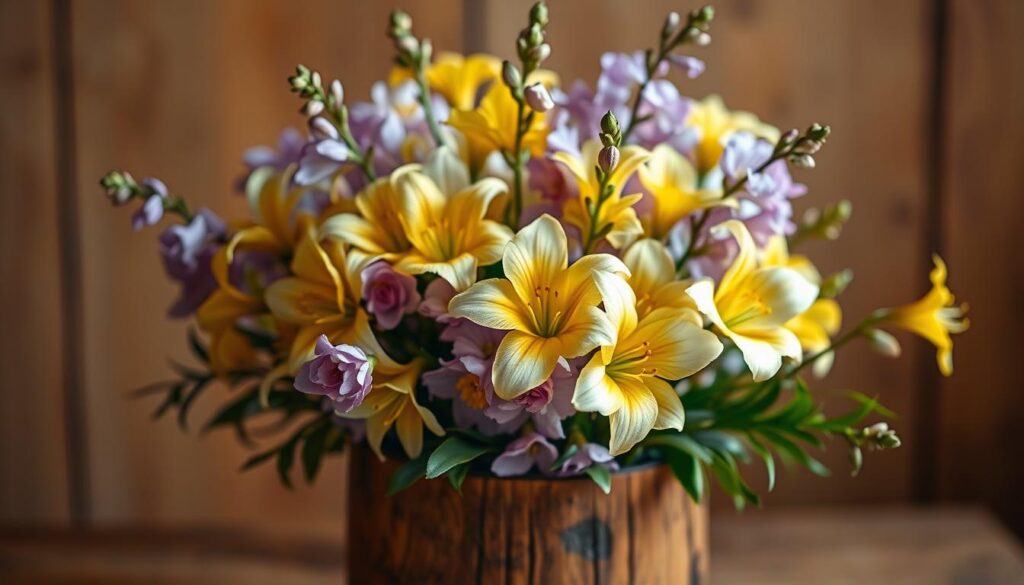
Creating Bouquets with Freesia
To make a beautiful freesia bouquet, pick a variety of flower sizes and colors. Mix large and small freesia with flowers like baby’s breath. This adds texture and depth to your arrangement.
Using Freesia in Floral Designs
Freesia flowers are great for centerpieces, wreaths, and garlands. Think about the arrangement’s theme and style when using freesia. For instance, a freesia and rose centerpiece can bring elegance to a wedding or dinner.
Propagating Freesia
Sharing freesia flowers with friends and family is easy. You can divide bulbs or grow from seeds. This way, you can enjoy freesia’s beauty and scent for many years. It’s important to care for the plants well to ensure they thrive.
There are two ways to propagate freesia: dividing bulbs or growing from seeds. Both need the right care, like enough water, nutrients, and sunlight. With the right conditions, you can grow new plants from bulbs or seeds.
Division of Bulbs
Dividing freesia bulbs is simple. You just separate the bulbs into smaller parts, each with a growth node. This method is great for quickly growing new plants to share. Following the right care tips will help your bulbs grow well.
Growing from Seeds
Growing freesia from seeds takes longer but is rewarding. Start by sowing seeds in good soil and give them the right care. With regular watering and fertilizing, you’ll soon have beautiful freesia blooms.
Overwintering Freesia Bulbs
To keep freesia bulbs alive and healthy, it’s key to care for them during winter. This means digging them up and storing them safely. Overwintering is crucial for the freesia plant’s health and growth.
Wait until the foliage dies back before digging up the bulbs. This usually happens after the first frost. Be gentle when digging to avoid damaging the bulbs. After digging, let the bulbs dry for a few days to prevent moisture damage.
Store the dried bulbs in a breathable container like a paper bag or wooden crate. Keep them in a cool, dry spot. The best storage is between 40°F and 50°F with low humidity. This care will help your freesia plant bloom beautifully for years.
Tips for Digging Up Bulbs
Use a fork to gently loosen the soil around the bulb. Work your way around it to avoid damage. This method ensures a successful overwintering.
Storage Conditions
Check on the bulbs often while they’re stored. This prevents them from drying out or rotting. With the right care, you’ll enjoy freesia blooms for many years.
Frequently Asked Questions about Freesia
Many people wonder if freesia flowers can grow in containers. The answer is yes. Freesia care is flexible, and these flowers do well in containers with the right sunlight and water. Container-grown freesia plants can brighten up your patio or balcony.
Another common question is about the best growing conditions for freesia flowers. To care for freesia well, use well-draining soil and give them full sun to partial shade. The ideal temperature is between 65-75°F (18-24°C). With the right care, your freesia flowers will bloom beautifully and fill the air with their sweet fragrance.
Can Freesia Grow in Containers?
Freesia care in containers needs a bit more attention. Use a well-draining potting mix and a container that’s at least 6-8 inches deep. Water your freesia plant regularly but avoid overwatering to prevent root rot. With proper care, your container-grown freesia will thrive and produce beautiful blooms.
What Are the Ideal Growing Conditions?
The best growing conditions for freesia flowers include well-draining soil, full sun to partial shade, and a temperature range of 65-75°F (18-24°C). It’s also important to provide your freesia plant with enough moisture but avoid overwatering. By following these guidelines, you’ll be able to give your freesia flowers the best care and enjoy their beautiful blooms.
By following these tips and guidelines, you’ll be able to provide the best possible care for your freesia flowers and enjoy their beautiful blooms. Whether you’re growing freesia in containers or in the ground, with proper freesia care, you’ll be able to enjoy these beautiful flowers for months to come.
| Freesia Care Tips | Description |
|---|---|
| Watering | Water regularly, but avoid overwatering |
| Soil | Well-draining soil with a pH between 6.0-7.0 |
| Temperature | 65-75°F (18-24°C) |
| Lighting | Full sun to partial shade |
Conclusion: Enjoying Your Freesia Blooms
Growing freesia flowers is a rewarding hobby. You’ve learned how to pick the best varieties and care for them. Now, you can grow these fragrant beauties in your garden.
The scent and colors of freesia flowers will make your senses happy. They add elegance to any arrangement or bouquet. Whether at home or shared with others, they bring natural beauty.
Keep nurturing your freesia plants and enjoy watching them grow. With proper care, you’ll enjoy their beauty for many years.
